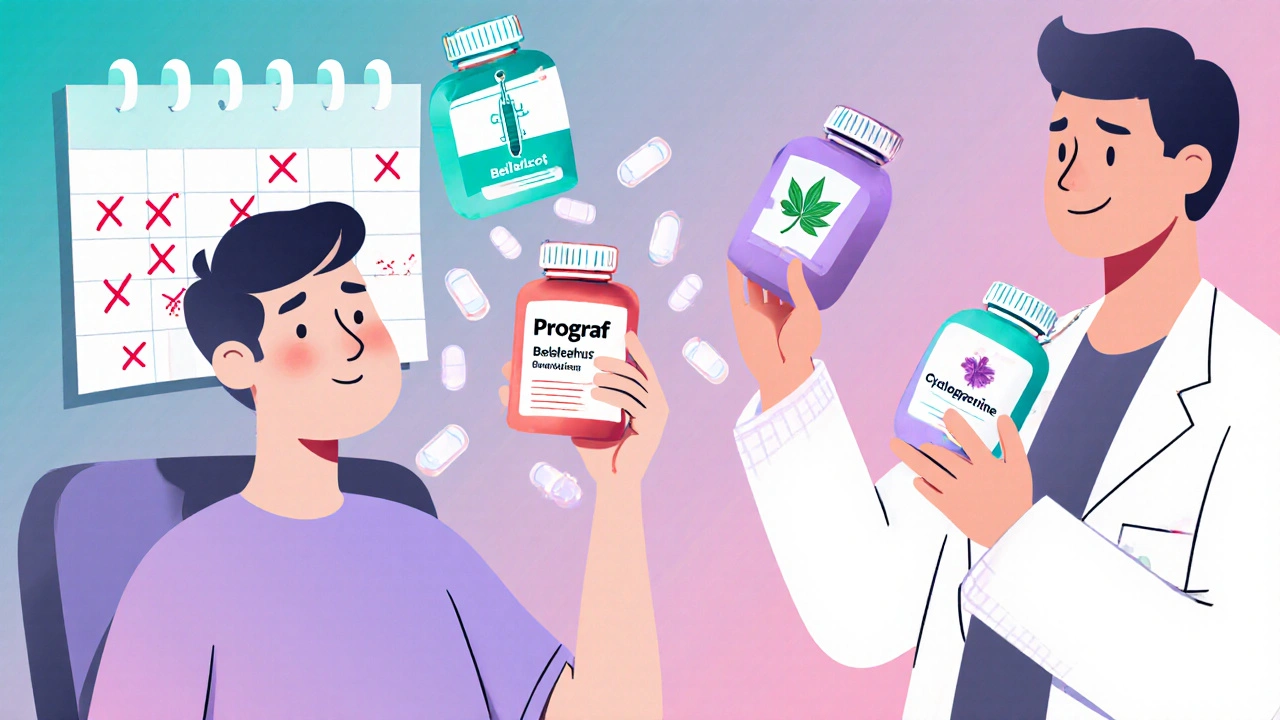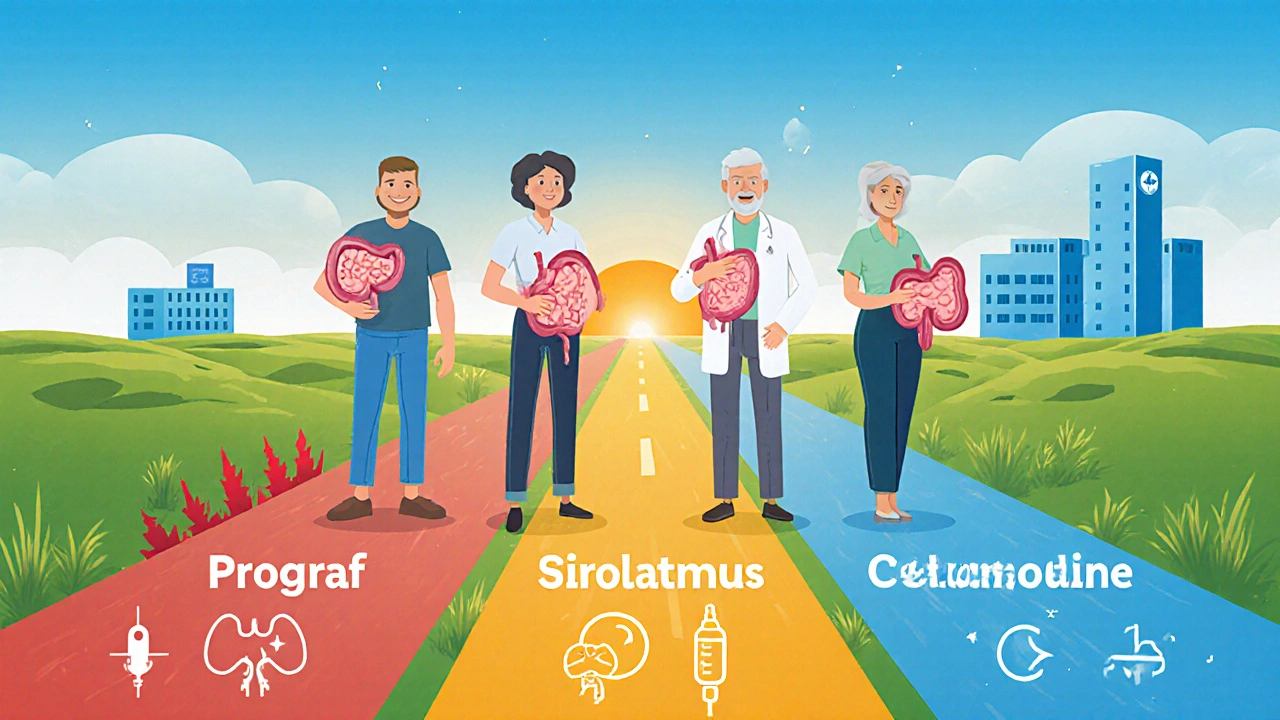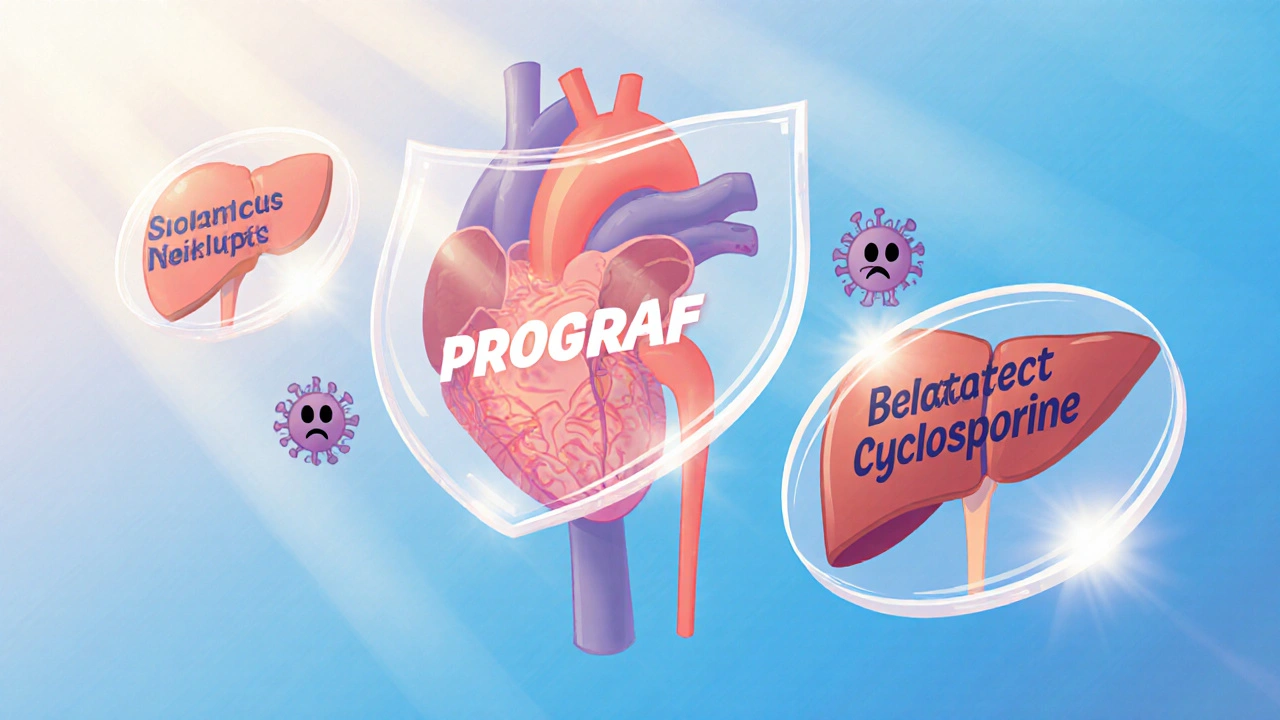Transplant Medication Comparison Tool
Which Medication Is Right For You?
Answer these questions to see which immunosuppressant might be best for your situation based on the latest transplant medicine research.
When you’ve had a transplant, your body doesn’t just accept the new organ-it fights it. That’s where Prograf (tacrolimus) comes in. It’s one of the most common drugs doctors prescribe to keep your immune system from rejecting your kidney, liver, or heart. But it’s not the only option. And for many people, it’s not the best fit. Side effects like tremors, high blood pressure, or kidney damage can make life harder, not better. So if you’re on Prograf and wondering if there’s something gentler, more effective, or just less taxing on your body, you’re not alone.
What Prograf (Tacrolimus) Actually Does
Prograf is the brand name for tacrolimus, an immunosuppressant that blocks a protein called calcineurin. This protein tells your T-cells-your body’s immune soldiers-to attack foreign tissue. By shutting it down, tacrolimus stops your immune system from seeing the transplanted organ as an invader. It’s powerful. And it works. In fact, studies show that tacrolimus reduces acute rejection rates in kidney transplant patients to under 15% in the first year, compared to 25-30% with older drugs like cyclosporine.
But here’s the catch: it’s a narrow therapeutic window drug. That means the difference between too little (risk of rejection) and too much (risk of toxicity) is small. Blood levels must be checked weekly at first, then monthly. Even a slight change in diet, other meds, or even a cold can throw your levels off. Many patients end up in the hospital because their tacrolimus dose wasn’t adjusted after starting a new antibiotic or eating grapefruit.
Why People Look for Alternatives
People switch from Prograf for three main reasons: side effects, cost, or lack of effectiveness.
- Side effects: Up to 40% of patients report tremors, headaches, or trouble sleeping. High blood sugar is common-some develop new-onset diabetes after transplant. Kidney damage from the drug itself is another concern, especially in liver transplant patients.
- Cost: Prograf can cost over $500 a month in the U.S. without insurance. Even with coverage, co-pays can hit $100+ per prescription. In Australia, it’s subsidized under the PBS, but not everyone qualifies for the full benefit.
- Effectiveness: Some patients never reach stable blood levels. Others reject the organ despite taking it. That’s when doctors look elsewhere.
Cyclosporine: The Old Standard
Cyclosporine was the go-to immunosuppressant before tacrolimus came along in the 1990s. It’s cheaper and has been used for decades. But it’s harsher on the kidneys and causes more hair growth, gum swelling, and high blood pressure. Studies comparing cyclosporine and tacrolimus show that tacrolimus leads to better long-term kidney survival. Still, cyclosporine remains an option for patients who can’t tolerate tacrolimus’s neurological side effects.
One key difference: cyclosporine is more affected by food. You have to take it the same way every day-either always with food or always without. Tacrolimus is more forgiving, but still needs consistency.
Sirolimus (Rapamune): A Different Kind of Shield
Sirolimus doesn’t work like tacrolimus. Instead of blocking calcineurin, it stops a different pathway called mTOR. This means it doesn’t cause the same nerve-related side effects. Many patients on sirolimus report fewer tremors and better sleep. It also doesn’t raise blood sugar as much.
But sirolimus has its own problems. It can cause mouth sores, high cholesterol, and slower wound healing. That’s why it’s often used after the first few months post-transplant, not right away. Some centers use it as a replacement for tacrolimus in patients who develop skin cancer or lymphoma-because sirolimus may actually lower cancer risk, unlike tacrolimus.
It’s also not used alone. It’s almost always combined with lower doses of tacrolimus or corticosteroids.

Belatacept (Nulojix): The Injection Option
Belatacept is the newest alternative. It’s given as an IV infusion every few weeks instead of a daily pill. It works by blocking the signal that activates T-cells-similar to sirolimus, but even more targeted.
Studies show patients on belatacept have better kidney function over time. One major trial found that after five years, 72% of kidney transplant patients on belatacept still had healthy kidney function, compared to 60% on tacrolimus. And they had lower rates of chronic kidney damage from the drug itself.
The downsides? It requires frequent clinic visits. And it increases the risk of post-transplant lymphoproliferative disorder (PTLD), especially in people who never had Epstein-Barr virus. That’s why it’s only approved for EBV-positive adults. It’s also expensive-over $100,000 a year in the U.S. In Australia, it’s available under the PBS for select cases, but access is limited.
Myfortic (Mycophenolate Mofetil): The Supporting Player
Myfortic isn’t usually a direct replacement for tacrolimus. But it’s almost always used with it. Myfortic blocks the growth of white blood cells that cause rejection. It’s a key part of the three-drug combo: tacrolimus + mycophenolate + steroids.
Some patients switch to Myfortic alone if they can’t tolerate tacrolimus’s side effects. But that’s rare. Myfortic causes nausea, diarrhea, and lowers white blood cell counts. It’s not strong enough on its own to prevent rejection in most cases.
There’s also an extended-release version, Myfortic EC, which reduces stomach upset. If you’re on mycophenolate and struggling with nausea, ask your pharmacist about switching.
How Doctors Decide What to Prescribe
There’s no one-size-fits-all. Your doctor will look at:
- Your type of transplant (kidney, liver, heart)
- Your age and overall health
- Whether you have diabetes, high blood pressure, or kidney disease
- Your genetic profile (some people metabolize tacrolimus faster or slower)
- Your ability to stick to a strict dosing schedule
- Your insurance or access to subsidized meds
For example, a 55-year-old with a kidney transplant and no history of diabetes might start on tacrolimus. But if they develop tremors or high blood sugar after three months, the doctor might switch them to sirolimus or lower the tacrolimus dose and add belatacept.
Older patients or those with liver transplants often do better on cyclosporine because their bodies handle it more predictably. Younger patients with good access to care might be candidates for belatacept.

Real Stories: What Patients Say
One patient in Perth, a 62-year-old retired teacher with a liver transplant, switched from Prograf to cyclosporine after developing severe hand tremors that made it hard to hold a coffee cup. Within two weeks, the shaking stopped. Her blood pressure went up slightly, but she managed it with diet and a low-dose pill.
A 48-year-old man in Melbourne switched to belatacept after two bouts of skin cancer. His doctor told him tacrolimus increases skin cancer risk by 3-5 times compared to other drugs. Belatacept didn’t eliminate the risk, but it lowered it. He now gets infusions every four weeks and says he feels more in control.
Another patient, a 31-year-old woman with a kidney transplant, couldn’t afford Prograf without a subsidy. Her doctor prescribed generic tacrolimus, which costs about $40 a month. She takes it with a light breakfast and checks her levels every two weeks. It’s not perfect, but it’s working.
When to Ask for a Change
You don’t have to suffer in silence. If you’re experiencing:
- Constant shaking or dizziness
- Unexplained weight gain or swelling
- High blood sugar (frequent thirst, frequent urination)
- Severe nausea or diarrhea
- Any new skin growths or sores that won’t heal
-talk to your transplant team. Don’t wait. Many side effects can be reversed if caught early.
Also, if you’re paying more than $100 a month out-of-pocket for Prograf, ask about generic tacrolimus. It’s the same drug, just cheaper. In Australia, the PBS covers it, but you need to be registered. Ask your pharmacist to check your eligibility.
What’s Coming Next
New drugs are in trials. One called voclosporin is a modified version of cyclosporine that works better at lower doses. Another, a once-weekly oral version of tacrolimus, is being tested for kidney transplant patients. If approved, it could cut down daily pill burden by 80%.
For now, the best choice depends on your body, your life, and your access to care. Prograf works for many. But it’s not the only path to a healthy transplant.
Is generic tacrolimus as good as Prograf?
Yes. Generic tacrolimus contains the exact same active ingredient as Prograf. The FDA and TGA (Australia’s drug regulator) require generics to match the brand in strength, purity, and how quickly they’re absorbed. Many transplant centers now prescribe generic tacrolimus as the first choice because it’s significantly cheaper-often 80% less than the brand name. Some patients notice slight differences in side effects, but that’s usually due to inactive ingredients, not the drug itself. If you switch brands, your doctor may check your blood levels once to make sure everything’s stable.
Can I stop taking Prograf if I feel fine?
Never stop or change your dose without talking to your transplant team. Even if you feel great, your body is still at risk of rejecting the organ. Rejection can happen silently-no pain, no fever. By the time you feel symptoms, it may be too late. Most rejection episodes happen within the first year, but they can occur years later. Staying on your medication is the single most important thing you can do to protect your transplant.
Does tacrolimus cause weight gain?
Tacrolimus doesn’t directly cause weight gain, but it can lead to it indirectly. It raises blood sugar, which increases hunger and fat storage. It also causes fluid retention in some people. Many transplant patients gain 10-20 pounds in the first year-not because they’re eating more, but because their metabolism changes. A diet low in sugar and processed carbs, plus regular walking, helps. Talk to your dietitian about a transplant-friendly meal plan.
Which alternative has the least side effects?
There’s no clear winner. Sirolimus has fewer neurological side effects than tacrolimus but can cause mouth sores and high cholesterol. Belatacept avoids kidney toxicity and high blood sugar but requires IV infusions and carries a small risk of lymphoma. Cyclosporine is easier on nerves but harder on kidneys and gums. The best choice depends on your personal risk factors. Your doctor can run blood tests to see how your body processes each drug and help you pick the one that fits your life.
Can I take natural supplements with tacrolimus?
Be extremely careful. Many supplements interfere with tacrolimus. St. John’s wort, echinacea, garlic pills, and grapefruit juice can all raise or lower your blood levels dangerously. Even vitamin C and fish oil can have effects. Always tell your transplant team about every supplement, herb, or vitamin you take-even if you think it’s harmless. What’s safe for one person can be deadly for another.
If you’re on Prograf and wondering if there’s a better option, talk to your transplant team. Bring a list of your symptoms, your medication costs, and your daily struggles. There’s no shame in seeking a better fit. Your transplant is your life-and you deserve a treatment plan that works with you, not against you.




Jillian Fisher on 28 October 2025, AT 18:53 PM
I’ve been on generic tacrolimus for 3 years now. My levels are stable, no tremors, and I save $400 a month. My pharmacist said the inactive ingredients can cause slight differences, but mine never did. Just make sure you get tested after switching.